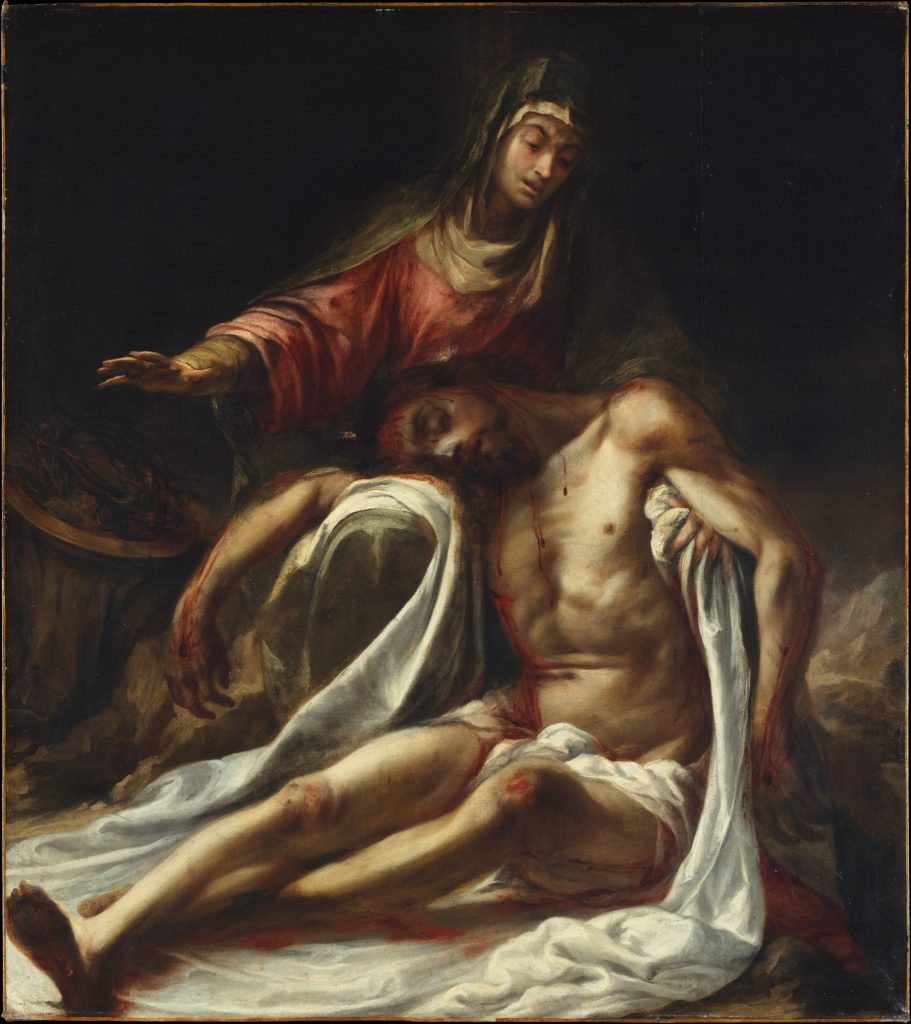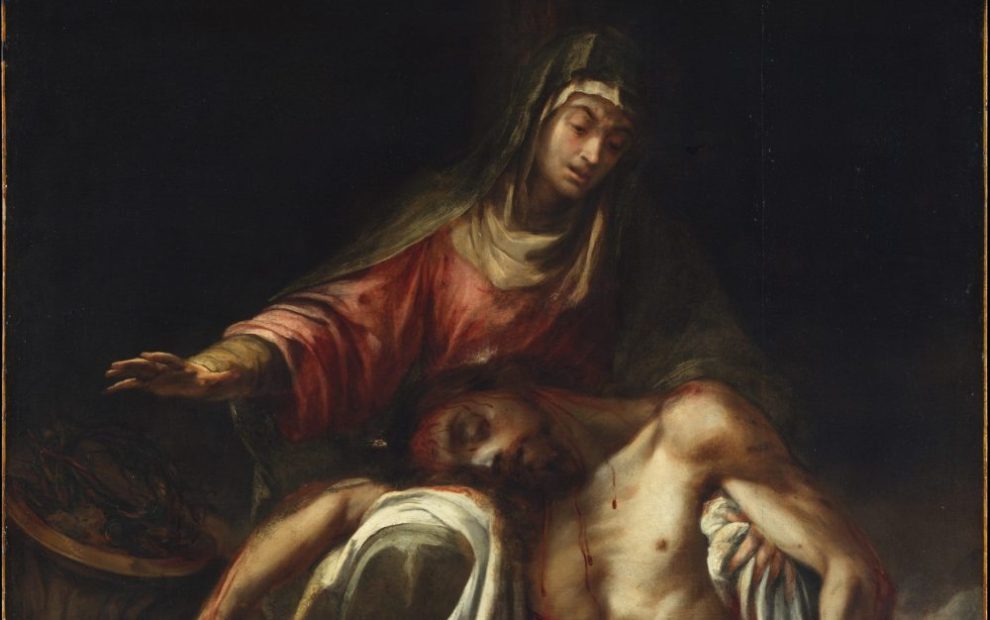My initial encounter with the 17th-century Spanish painter Juan de Valdés Leal’s Pietà came at an auspicious moment in my spiritual journey. After having drifted from structured religious expression in general, and the Catholic Church in particular, I was, at the time, in the midst of finding my way back.
I was beginning to approach that point where the Christ I had carried with me as an extended metaphor for mankind’s suffering solitariness was rapidly becoming human. I mean to say that what I had known foremost as a kind of literary symbol—albeit one intensified by 2,000 years of cultural history—was transforming into something at once more simple and more profound: the flesh and blood of a man who was born, lived, and died on earth.
Contact with Leal’s painting hastened this shift in my perception. To experience his Christ is to be shocked out of years of accrued Christian allegory and plunged into the cold water of Christian reality: Jesus was an historical figure who died a common criminal, whose life terminated in a crumpled heap indistinguishable from so many broken bodies before and after his.
I can’t overstate how revelatory this was for me at the time. In those early days of a personal reawakening of faith, graced by my first undeniable intuition of Christ as God, Leal’s image of a battered man with head slumped lifelessly over his mother’s lap brought me face-to-face with the pinnacle of Christ’s humanity and its deepest trench: his death.

Viewing a reproduction of the painting today I see how so many elements of the composition—Mary’s veil and outstretched hand; Christ’s dangling limbs and fingers; his legs, having hit the ground, declining to the lower left where the weight of the darkened foot seems to want to pull the body right out of the frame—gravitate downward, following a line from the slope of Mary’s nose to the tracks of Christ’s blood and cataracts of linen shroud.
I am prompted to follow this line still further to imagine the underworld that is the final destination of Christ’s descent. It is this unpainted passage into Holy Saturday, the harrowing of Hades, that is the real subject of Leal’s Pietà. As I meditate on Christ’s downward motion into “the depths of the pit” (Ps. 88:6), I see how it connects visually with the top half of the painting: that dark, tenebrous background from which Mary emerges like a specter is the same darkness of Christ’s tomb.
Leal does not show us this tomb, of course, much less Christ’s salvific work within it, but in that vast swath of black we experience it in all of its obscurity. This is the black of the Spanish mystics, the nada of St. John of the Cross, the apophatic space of a God who resists all appellations.
The longer we look at the painting and feel the movement of Christ’s sinking body, the greater our awareness of this blackness as palpable presence. Our eye becomes its own Joseph of Arimathea, traversing Christ’s deathward trajectory, circling back to experience his entombment in the sepulchral shadows, and coming to rest on the pallor of his face.
No matter how our eye spirals over the image, it is brought back to Christ’s face with an almost centripetal force. It is the still point around which the whole canvas turns, the visual keystone that—like Christ himself—is at once part of the surrounding composition and separated from it in its role of holding everything together.
This feeling of separateness is heightened by the perpendicularity of Jesus’ head to the rest of his body, disrupting the vertical axis that comes down through Mary’s sagittal plane to divide the canvas in half lengthwise; look long enough and the face becomes an object of meditation in and of itself, acquiring the charged autonomy of an icon.
Studying the painting, the words of the Methodist theologian Walter Wink echo in my mind: “This is really what God is: HUMAN. . . . If God is true humanness, then divinity inverts. Divinity is not a qualitatively different reality; quite the reverse, divinity is fully realized humanity.”
The hollows of the eyes, the tip of the bloodless nose do not portray suffering for its own sake. Rather, they are a representation of enfleshed divinity: humanity that endures all abasement, humiliation, and affliction to love both God and neighbor unto death.
Christ did this perfectly, without sin; our limitations make it much more difficult to follow his pattern of fully actualized humanness, which is why Wink could write:
“It is the great error of humanity to believe that it is human. We are only fragmentarily human, brokenly human. . . . Only God is human, and we are made in God’s image and likeness—which is to say, we are capable of becoming human.”
Only God is human. In coupling Wink’s words with Leal’s image, it becomes painfully clear that the purpose of creation, its very raison d’être, was for God to inhabit it as man—and not as man immune to suffering, but as one who accepts the earthly cycle of life and death, even the ignominious death of the cross.
The cross is the organizing principle of the entire cosmos: we have been lurching toward it since the beginning of time, and we are lurching toward it still. The entire universe was created for that one instant when the uncreated God could disclose divinity upon it in an act of utterly selfless love. The moment Leal depicts marks the terminal point of God’s life as human but the origin of human’s life in God.
Lest we be overwhelmed by the awesomeness of responsibility such a transition implies, Wink reiterates that “the goal of life . . . is not to become something we are not—divine—but to become what we truly are—human.”
We begin to do this when we realize that the faith, hope, and love we crave will not arrive fully formed within our lives the moment we assent to some belief or spiritual practice but must be tested, essayed, cultivated, pursued, and that this ongoing process of searching and finding and discarding and searching again is precisely how God breaks us in that his life might break into ours. Leal’s Pietà gives us a Christ whose wounds are a template for our own, collected as we make this mutable journey toward his immutable peace.
Image: Juan de Valdés Leal, Pietà, ca. 1657-1660, oil on canvas, Metropolitian Museum of Art, New York.













Add comment